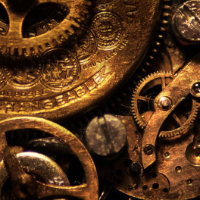Kastion said: Simple Way to have a "Handout" without a Journal Entry or Actually Making a Handout I've been using this method a lot recently to show handouts based on what they see in a room or somewhere on the map. I've done this a lot for books, journals, mystic scripts and alchemy recipe books among other things. Step 1: Use photoshop or GIMP to create an image with as much text as you want to display (In my instances I've used a high-res images of aged parchment and aged open books showing text on both pages.) Step 2: Upload the image to your Roll20 Library. I have a folder for things like this: *snip* Step 3: Place the image on the map somewhere as a token at a location you want the party to find and read the content of the book/scroll/etc. It will show up filling a full unit (Default 70 x 70 pixels) and look a too large or out of place so right click on the token and select "Advanced --> is Drawing" then shrink it down to an appropriate level and possibly rotate it to make it look more organic. Mine looks like this: *snip* Step 4: Once they are in the room and say "I want to read the Journal" or "I want to see what the scroll says", etc etc. select the journal token then press SHIFT+Z this will show it to all players. You see how small that journal looks on the table? This is what the players see after pressing SHIFT-Z *snip * Doing all this lets you add readable books, scrolls, mystic script, notes, alchemy recipes, tactics or fighting treatise / instructions among many other things without having to create a Handout and having it as a "single use handout". Having these littered around your dungeon or cave or any area with intelligent / semi-intelligent creatures helps with world building and makes for a nice change of pace to just "Walk in room, see 4 orcs, kill orcs, take treasure, move on to next room." I have a long list of things like this I do to break the monotony of just combat encounters when in some stronghold or dungeon scenario. Do you by chance have a Template which we'd be able to use for a Scroll/Book in case we desire to create our own versions? this actually reminds me of a Tip that has yet to be mentioned here! This is actually a Double Tip! Resizing Images to Scale: Quick & Easy! Smoother Resized Images! When you go to upload a desired Image, it can be a pain to get everything scaled properly, especially a Raw (unscaled, unsquared, unedited) image, & when you edit it, sometimes it comes out Choppy, Blurry, Fuzzy, or just plain Odd; But, fret not! For there are a few simple & easy methods for fixing this: 1: if you are familiar with the classic Excel Spreadsheets, you likely know that they had a command for figuring out when 2 numbers would eventually meet if you kept adding the original number. Nowadays though, Microsoft holds that Program & asks for money, although there is a Freeware variant known as "OpenOffice Calc" as a part of the OpenOffice package of Text Editors (Link: Their Download Page ) For example: Key: $x "Do not Change x in Copy/Paste" = "Formula" Roll20 Sizes Raw Picture Size Formula for Result 70 512 =SUM(A2*B2) =SUM(A2;A$2) =SUM(B2;B$2) =LCM(A2;B2) =SUM(A3;A$2) =SUM(B3;B$2) =SUM(A4;A$2) =SUM(B4;B$2) =SUM(A5;A$2) =SUM(B5;B$2) 2: if you are unable/unwilling to use the above formula (only needs the 3x1 area on Row 2, the rest is explanatory & entirely optional), you can still do it using 1 or 2 Calculators. You can spend time adding it all together, finding the lowest possible combination, or, you can take a shortcut: (A*B) = (C) = (B*A) (C/A) = (B) (C/B) = (A) 3: This can be used to figure out how Small you want to make something as well! in the Table above, you will notice I have a formula called " LCM() ", this can be used with up to 30 numbers to find out their " L east C ommon M ultiple", for example: =LCM(70;140;512) shows they all share the number 17,920 so you know what you want to resize the image to in order to create a smooth picture, This is useful for Maps which do not follow the standard Grid Size (I have not yet figured out how it works it's math tho). A lot of Resizing Methods use "Blending" or "Anti-aliasing" to force the Square Peg into the Round Hole, this way you can smoothly make the entire image Fit, without needing to lose out on quality, although, fair warning, you are going to want to have a good amount of RAM to make an image that large, as even a 7,000 x 7,000 Pixel Image can easily need half a Gig (512 MB) of RAM, and you'll still need to Shrink it afterwards to a more reasonable size (3,500 x 3,500 = 50 x 50 Units)












